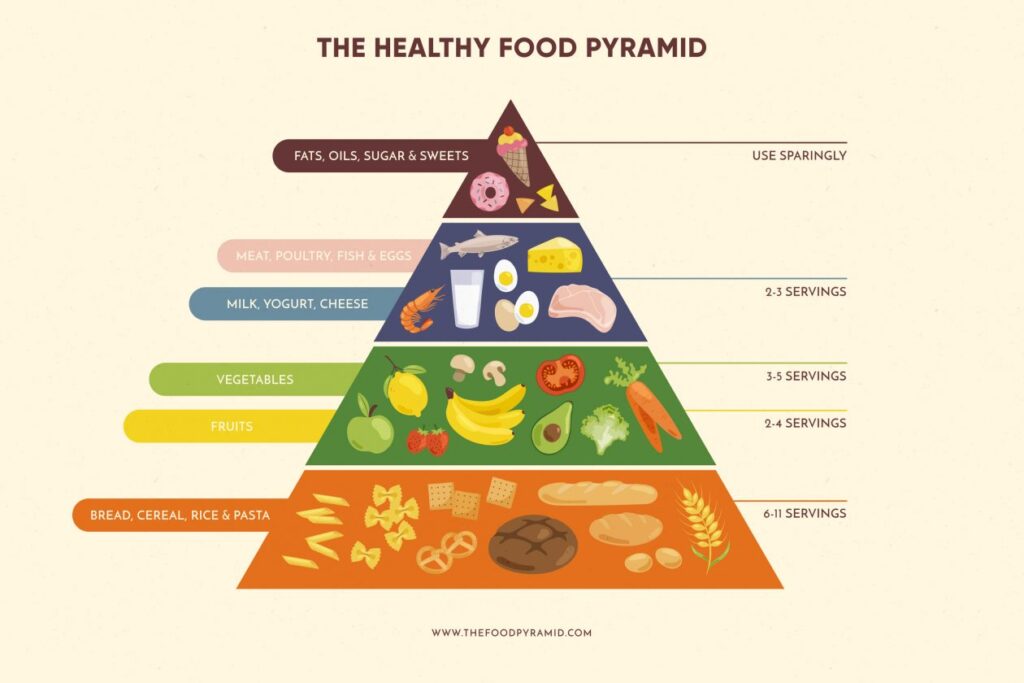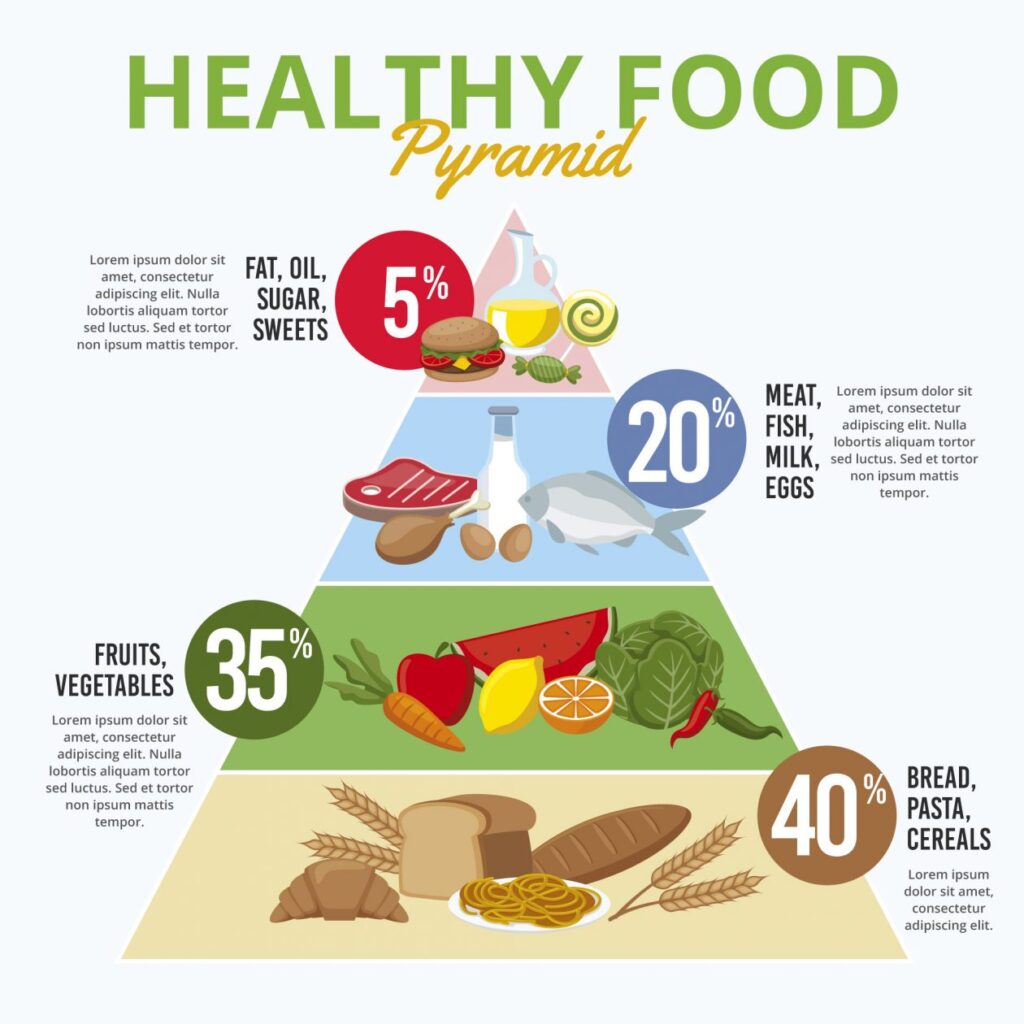I.Introduction
The food pyramid is a visual aid that people can use to make educated decisions about food. Its main goal is to list the appropriate food kinds and portions that make up a balanced diet. People may make healthier eating choices and better food decisions by knowing the fundamentals of the food pyramid.
Longevity and general well-being depend on eating a balanced diet. The food pyramid, which offers an organized framework for planning meals and snacks, is essential. It underlines how crucial it is to satisfy the body’s nutritional demands by eating nutrient-rich meals in sensible amounts.
For those who want to change their eating habits, it is essential to comprehend how the food pyramid supports a balanced diet. According to its rules, people may ensure they are obtaining the proper balance of vital nutrients, vitamins, and minerals required for optimum health. The food pyramid is useful for encouraging a balanced diet and general well-being.
Understanding the Food Pyramid

The food pyramid shows how much of each food type should be consumed daily to maintain a balanced diet and improve general health. It offers recommendations for the appropriate serving sizes of each category and divides foods into several categories according to their nutritional content. People can make educated decisions about their eating habits and meet their dietary demands while avoiding deficits by adhering to the food pyramid.
Food groups like fruits, vegetables, and whole grains that should be consumed in greater amounts are at the base of the food pyramid. These foods are high in dietary fiber, vital vitamins, and minerals necessary to preserve good health. Food groups like dairy, lean proteins, and fats are higher up the pyramid and should be consumed in moderation to support a variety of body processes and give energy.
Promoting balance in daily food intake is one of the fundamental tenets of the food pyramid. One way to ensure kids get all the nutrients they need for a healthy diet is to include various items from each food category. The food pyramid strongly emphasizes moderation and portion control, which can help people satisfy their nutritional needs without overindulging in particular foods.
In conclusion, people who want to increase their nutritional intake and maintain a balanced diet will benefit greatly from using the food pyramid. People can make more informed food choices and improve their health and well-being by knowing the categories and serving sizes.
Portion Control and Balanced Nutrition

The food pyramid is useful for people who want to manage portion sizes and attain balanced nutrition in their meals. The pyramid assists people in making educated decisions regarding their food consumption by grouping foods into distinct categories and suggesting particular serving sizes for each group. The food pyramid’s emphasis on portion control—crucial for preserving a healthy weight and avoiding overindulgence—is among its principal advantages. People can prevent overindulging in calories and maintain a balanced diet by adhering to the pyramid’s suggested serving sizes.
A balanced diet is crucial for general health and well-being, and the food pyramid offers a framework for reaching this objective. One way to ensure kids get all the nutrients they need for good health is to eat various foods from each food category. For instance, the pyramid suggests eating many fruits and vegetables because they are high in dietary fiber, vitamins, and minerals. It also highlights how crucial it is to include whole grains, lean proteins, and healthy fats in the diet to support various body functions and encourage fullness.
To demonstrate the idea of balanced nutrition, the food pyramid offers suggested serving sizes for each food group. It recommends, for example, eating three to five servings of fruits and vegetables per day, in addition to six to eleven meals of grains and two to three servings of dairy or dairy substitutes. People can meet their nutritional demands and maintain a healthy diet by adhering to these recommendations. The food pyramid is an effective tool for encouraging portion management and a balanced diet, assisting people in making better decisions and enhancing their general health.
Simplifying Grocery Shopping
The food pyramid is an excellent resource for streamlining grocery shopping since it offers precise recommendations for the kinds and amounts of foods that should be a part of a balanced diet. Following the pyramid’s guidelines makes it simple to make grocery lists highlighting wholesome items from each dietary group. The pyramid, for instance, advises consuming a diet rich in fruits, vegetables, whole grains, lean meats, and healthy fats. These recommendations can form the basis of a shopping list that is well-balanced.
Planning meals is simpler when you follow the food pyramid’s guidelines. Meal plans that include the suggested servings from each food group help people ensure they get the nutrients they need and consume various meals all week. When meal plans are created using the concepts of the food pyramid, people can cook with more creativity and variety since they can try new dishes and ingredients while adhering to the suggested amounts.
I recommend that readers use the food pyramid as a useful resource for planning meals and conducting orderly shopping. People can use the pyramid regularly to enhance their nutritional intake, form healthy eating habits, and make grocery shopping and meal preparation easier. The food pyramid provides insightful information and useful advice for accomplishing your dietary objectives, whether you intend to adopt a healthier diet or are just looking for direction on choosing better foods. Embrace the pyramid as part of your daily routine and reap the rewards of eating a balanced diet.
Promoting Nutrient-Dense Choices
The food pyramid is an effective tool for encouraging the selection of nutrient-dense foods over those high in empty calories. The pyramid emphasizes eating a range of nutrient-rich foods from each food group, which helps people prioritize meals that offer vital vitamins, minerals, and other nutrients needed for good health. The pyramid helps people make better eating decisions by encouraging them to think about the nutritional content of the foods they choose rather than just counting calories.
For instance, the food pyramid suggests including many in one’s diet because fruits and vegetables are high in vitamins, minerals, fiber, and antioxidants. People may ensure they get all the nutrients they need daily while savoring diverse tastes and sensations by including vibrant fruits and vegetables in their meals and snacks. The pyramid also promotes healthy fats, lean proteins, and whole grains, vital for general health and well-being.
Overall, by encouraging nutrient-dense selections from each food group, the food pyramid is a useful guide for choosing healthier foods. People can increase their overall nutritional intake, lower their chance of developing chronic diseases, and improve their general quality of life by adhering to the guidelines provided in the pyramid. Nutrient-rich meals offer people the energy and vigor they require to survive daily and are also good for mental, emotional, and physical health.
Encouraging Physical Activity
The food pyramid stresses the value of physical activity in sustaining a healthy lifestyle and outlining nutritional guidelines. The pyramid demonstrates the relationship between a balanced diet and regular exercise, which motivates people to take a comprehensive approach to their health. Maintaining a healthy weight, enhancing cardiovascular health, elevating mood, and lowering the risk of chronic illnesses like diabetes and heart disease are all made possible by physical activity, which is crucial for overall health.
The advantages of a healthy lifestyle can be further increased by regularly participating in physical exercise and adhering to the nutritional recommendations shown in the food pyramid. At least 150 minutes of moderate-intensity activity per week, such as brisk walking, swimming, or cycling, is advised by the pyramid. Strength training exercises can also assist in maintaining and increasing muscle mass, enhancing bone density, and speeding up metabolism when added to a routine.
People can include physical activity daily to make exercise more accessible and pleasurable. This can involve walking or biking to work, using the stairs rather than the elevator, or engaging in physically demanding pastimes like dance or gardening. People who engage in activities they enjoy are more likely to maintain their fitness regimen and profit in the long run from leading an active lifestyle.
In conclusion, the food pyramid emphasizes combining a healthy diet with frequent exercise to promote general health and well-being. People can improve their health and lower their risk of chronic diseases by including exercise in their daily routines and according to the dietary guidelines in the pyramid. This will ultimately result in an improved quality of life.
Customizability and Adaptability
The food pyramid is a flexible tool that may be tailored to each person’s specific dietary requirements and preferences. Although it offers broad recommendations for a healthy diet, it also permits customization and modification in response to various variables, including dietary choices, cultural background, dietary restrictions, and way of life. This flexibility guarantees that anyone who wants to lose weight, manage a health issue, or keep their general well-being may design a diet plan that fits their unique needs and goals.
One of its main advantages is the food pyramid’s adaptability to a wide range of dietary needs and limits. For instance, vegetarian or vegan diets can alter the pyramid by emphasizing plant-based protein sources such as beans, tofu, and nuts and lowering or avoiding animal products. In a similar vein, people who have celiac disease or gluten intolerance can replace wheat-based items with gluten-free grains and substitutes. By making these adjustments, people can still achieve their nutritional needs while adhering to their dietary preferences and constraints.
Moreover, the food pyramid can be modified to accommodate different lifestyle choices, such as low-carb, keto, or intermittent fasting. These methods can still align with the pyramid’s general principles, which include prioritizing nutrient-dense options, restricting processed meals, and encouraging whole foods, even though they may consist of alternative macronutrient distributions or meal scheduling techniques. Because of this flexibility, people can experiment with varied eating habits while ensuring a healthy, balanced diet.
In conclusion, the food pyramid’s flexibility and customizability enable people to tailor their diets to suit their requirements, tastes, and lifestyles. By customizing the pyramid to fit specific situations, people can design a fun and sustainable eating plan that promotes their general health and well-being.
Long-Term Health Benefits
Following the food pyramid guidelines when choosing a diet has several long-term health advantages that can greatly enhance general well-being. People can develop good eating habits that support optimal nutrition and lead to better health outcomes over time by adhering to the pyramid’s guidelines. The food pyramid strongly focuses on eating a range of nutrient-dense foods from all food groups, which is one of its main benefits. This well-rounded strategy guarantees people the vital vitamins, minerals, and other nutrients to stay healthy and perform at their best.
Furthermore, studies have repeatedly demonstrated that following the dietary pyramid can lower the chance of contracting chronic illnesses, including diabetes, heart disease, and several types of cancer. Saturated fats, cholesterol, and added sugars are linked to a higher risk of chronic diseases. People can reduce their consumption of these substances by prioritizing whole grains, fruits, vegetables, lean meats, and healthy fats. The fiber-rich foods in the pyramid also help with weight management, blood sugar regulation, and digestive health, lowering the risk of developing chronic illnesses.
Moreover, many testimonies and academic research offer persuasive proof of the food pyramid’s efficacy in fostering enduring health and welfare. Numerous people who have embraced the pyramid’s ideas report benefits in their overall quality of life, energy levels, mood, and digestion. Furthermore, studies have shown a correlation between diets that follow the food pyramid and decreased rates of obesity, hypertension, and other chronic disease risk factors. People can feel more confident in the food pyramid’s long-term health benefits and inspired to undertake sustainable dietary adjustments for better health outcomes when testimonies and research findings are included in talks about the pyramid’s benefits.
How Does a Food Pyramid Help Individuals Eat a Healthy Diet?
A. Answer in Short: The food pyramid serves as a visual guide that outlines the recommended daily intake of various food groups essential for maintaining a healthy diet. It categorizes foods into groups based on nutritional value and provides guidelines on portion sizes to promote balanced nutrition. By following the food pyramid, individuals can make informed choices about their dietary habits, ensuring they consume adequate nutrients for optimal health and well-being.
B. Answer in Depth: The food pyramid is a valuable tool designed to help individuals make healthier choices and achieve balanced nutrition. It emphasizes the importance of consuming various nutrient-dense foods from all food groups, including fruits, vegetables, grains, protein sources, and dairy products. Each food group provides essential nutrients such as vitamins, minerals, protein, carbohydrates, and fats, necessary for supporting various bodily functions and maintaining overall health.
One of the key benefits of the food pyramid is its ability to promote portion control and moderation. By dividing foods into different categories and recommending specific serving sizes, the pyramid encourages individuals to be mindful of their food intake and avoid overeating. This approach helps prevent excessive calorie consumption and promotes weight management, reducing the risk of obesity and related health conditions.
Furthermore, the food pyramid is adaptable to individual dietary needs and preferences, allowing for customization based on age, gender, activity level, and health status. It provides flexibility in food choices while ensuring that essential nutrients are adequately met. By following the principles of the food pyramid and incorporating various foods into their diet, individuals can meet their nutritional requirements and support long-term health and well-being.
In summary, the food pyramid is a practical guide for individuals seeking to adopt a healthy diet. It offers clear recommendations on the types and amounts of foods to consume daily, promoting balanced nutrition and portion control. By following the principles of the food pyramid, individuals can make informed dietary choices, reduce the risk of chronic diseases, and improve overall health outcomes. Customizable to individual needs and preferences, the food pyramid provides a flexible framework for achieving optimal nutrition and supporting long-term well-being.
FAQ Section about Healthy Eating Pyramid
Q: What is the Healthy Eating Pyramid model?
A: The Healthy Eating Pyramid model visually represents a balanced diet, depicting the recommended intake of different food groups for optimal health. It was developed to guide individuals in making healthier food choices and promoting overall well-being.
Q: How does a food pyramid help individuals eat a healthy diet?
A: The food pyramid provides a structured approach to healthy eating by categorizing foods into different groups based on nutritional value. It offers guidelines on portion sizes and encourages the consumption of various nutrient-dense foods, such as fruits, vegetables, whole grains, lean proteins, and dairy products.
Q: What is the importance of the food pyramid in your diet?
A: The food pyramid is important in promoting balanced nutrition and helping individuals meet their daily dietary requirements. It is a practical tool for planning meals, controlling portion sizes, and ensuring adequate intake of essential nutrients, leading to better health outcomes.
Q: What are the five levels of the food pyramid?
A: The five levels of the food pyramid typically represent different food groups, including fruits, vegetables, grains, protein sources, and dairy products. Each level emphasizes the importance of consuming foods from these groups in appropriate proportions for a balanced diet.
Q: How do you explain the food pyramid?
A: The food pyramid is a visual representation of a healthy diet, illustrating the recommended intake of various food groups to achieve balanced nutrition. It helps individuals understand the importance of including different types of foods in their diet and promotes portion control for optimal health.
Q: How do you have a balanced diet?
A: A balanced diet involves consuming various nutrient-dense foods from all food groups, including fruits, vegetables, whole grains, lean proteins, and dairy products. It also entails controlling portion sizes, staying hydrated, and limiting unhealthy fats, sugars, and processed foods intake.
Q: What does a healthy diet consist of?
A: A healthy diet consists of a diverse range of nutrient-rich foods that provide essential vitamins, minerals, protein, carbohydrates, and fats. It includes plenty of fruits and vegetables, whole grains, lean proteins, and dairy products while limiting saturated fats, added sugars, and sodium intake.
Q: How can the food pyramid guide help you maintain good health?
A: The food pyramid guide can help individuals maintain good health by offering practical recommendations for healthy eating. It encourages the consumption of various nutritious foods in appropriate portions, improving overall well-being and reducing the risk of chronic diseases.
Conclusion
In summary, the food pyramid emphasizes the fundamentals of a balanced diet, making it a useful tool for maintaining a healthy diet. It supports people in making decisions that promote general health by grouping foods into categories and suggesting sensible serving sizes. The food pyramid encourages the intake of a range of nutrient-dense foods, such as fruits, vegetables, whole grains, lean proteins, and dairy products, through its structured approach.
I urge readers to use the food pyramid as a useful resource for better eating. People can improve the quality of their diet and more effectively meet their nutritional demands by adhering to its suggestions and implementing its ideas into their regular meal planning. The food pyramid provides useful advice for choosing better foods and keeping a balanced diet, whether it’s through meal planning, grocery lists, or portion control.
Adopting the tenets of the food pyramid can have a lasting positive impact on people’s health and well-being. Following its recommendations consistently can result in more energy, better weight management, a lower chance of developing chronic illnesses, and an all-around higher standard of living. Therefore, I urge everyone to incorporate the food pyramid’s tenets into everyday routines for long-term health benefits.
Reference
“Healthy Eating Pyramid.” 2019. The Nutrition Source. January 4, 2019. https://www.hsph.harvard.edu/nutritionsource/healthy-eating-pyramid/.
“”Food Pyramid.”” 2020. Dental Health Foundation. May 20, 2020. https://www.dentalhealth.ie/adult-oral-health/the-healthy-mouth/food-pyramid/.
“”Food Pyramid | Origins, History, Variations, Debates, & Facts | Britannica.”” 2024. In Encyclopædia Britannica. https://www.britannica.com/science/food-pyramid.
“The New Food Pyramid (Washingtonpost.com).” 2024. Washingtonpost.com. 2024. https://www.washingtonpost.com/wp-srv/nation/daily/graphics/diet_042005.html?itid=lk_inline_manual_10.
Was this helpful?

Joseph Emb, RDN
Founder of StyleVitally.com | Registered Dietitian & Wellness Advocate
What I Cover:
I’m passionate about connecting nutrition science and everyday wellness to help people live healthier, more vibrant lives. I write about evidence-based nutrition, mindful eating, sustainable lifestyles, and holistic well-being at StyleVitally.com.
My Background:
The University of Texas in Austin, where I earned my Dietetics diploma, laid the groundwork for my nutrition and health career. My training and hands-on experience taught me the science and art of using nutrition to enhance health and well-being.
Professional Journey:
I’m an RDN with lots of experience. I’ve helped people seeking tailored nutritional recommendations in clinical settings and community outreach programs. My constant learning and professional development ensure that my recommendations are always based on the latest evidence.
Ethical Commitment:
My practice prioritizes integrity. My content is transparent and objective, following the most significant ethical standards. I can give my audience unbiased advice because I’m not affiliated with food businesses or industry associations. I want to help people make informed health decisions that match their values and ambitions.
Join Me on the Wellness Journey:
Join me on the path to vitality and well-being, whether facing nutritional issues, seeking sustainable lifestyle changes, or simply wanting a better, happier you. We’ll discover how diet, mindfulness, and holistic well-being can maximize your potential.









